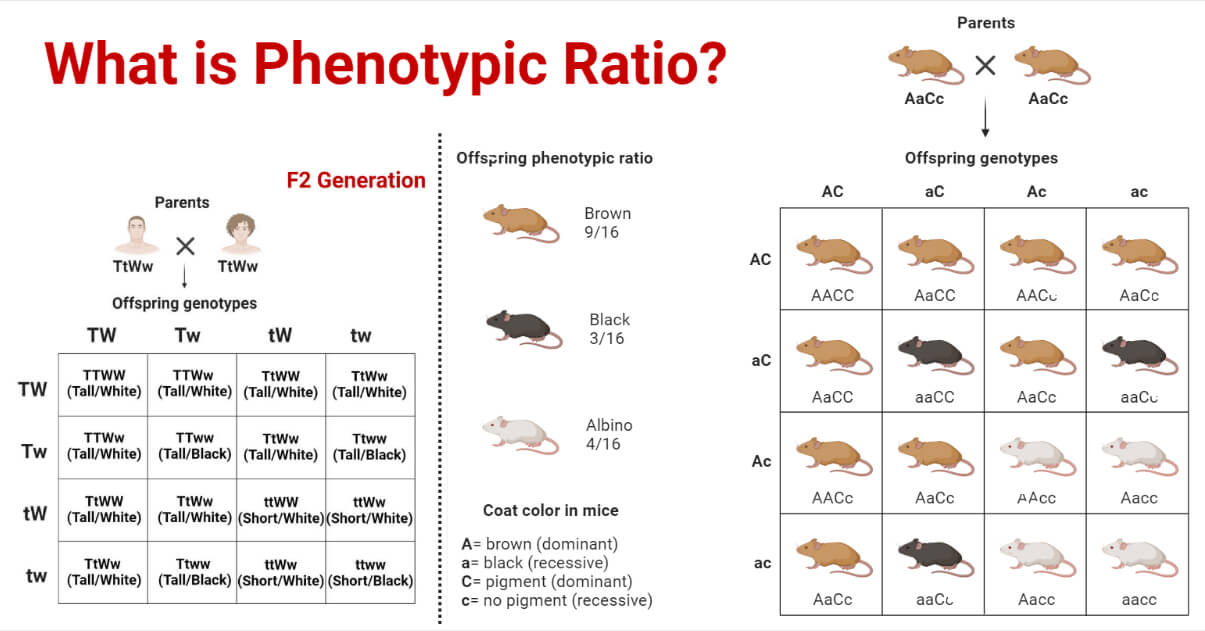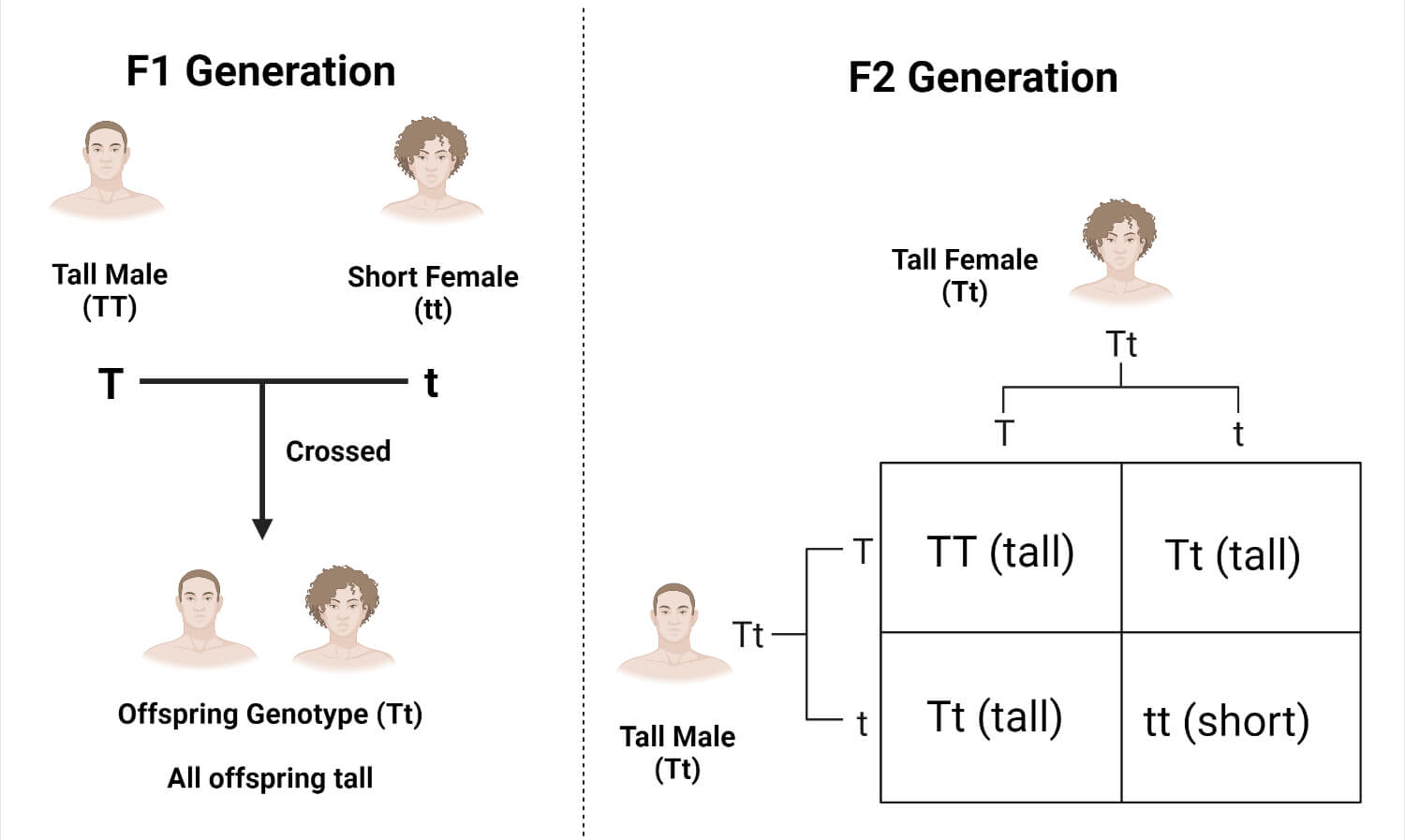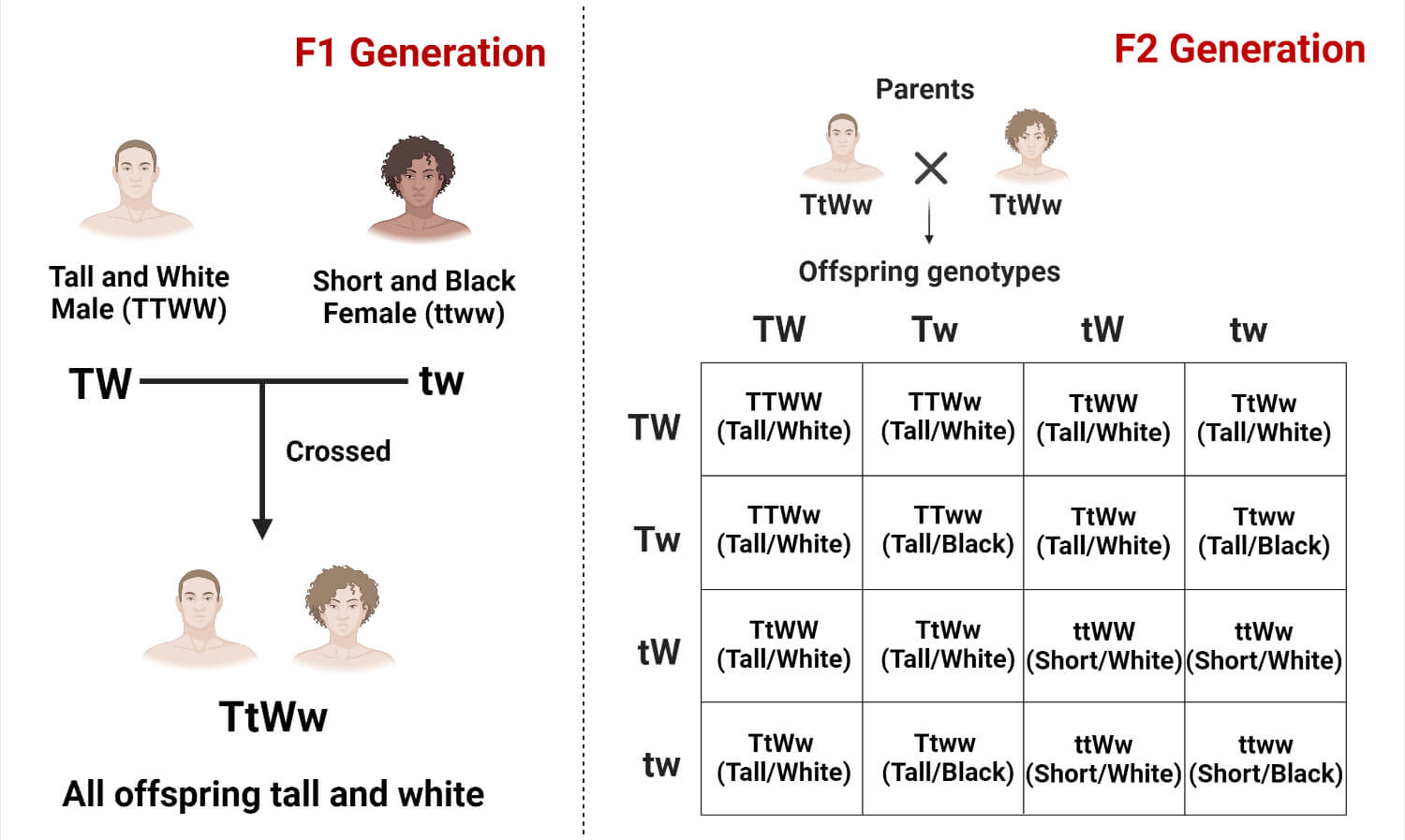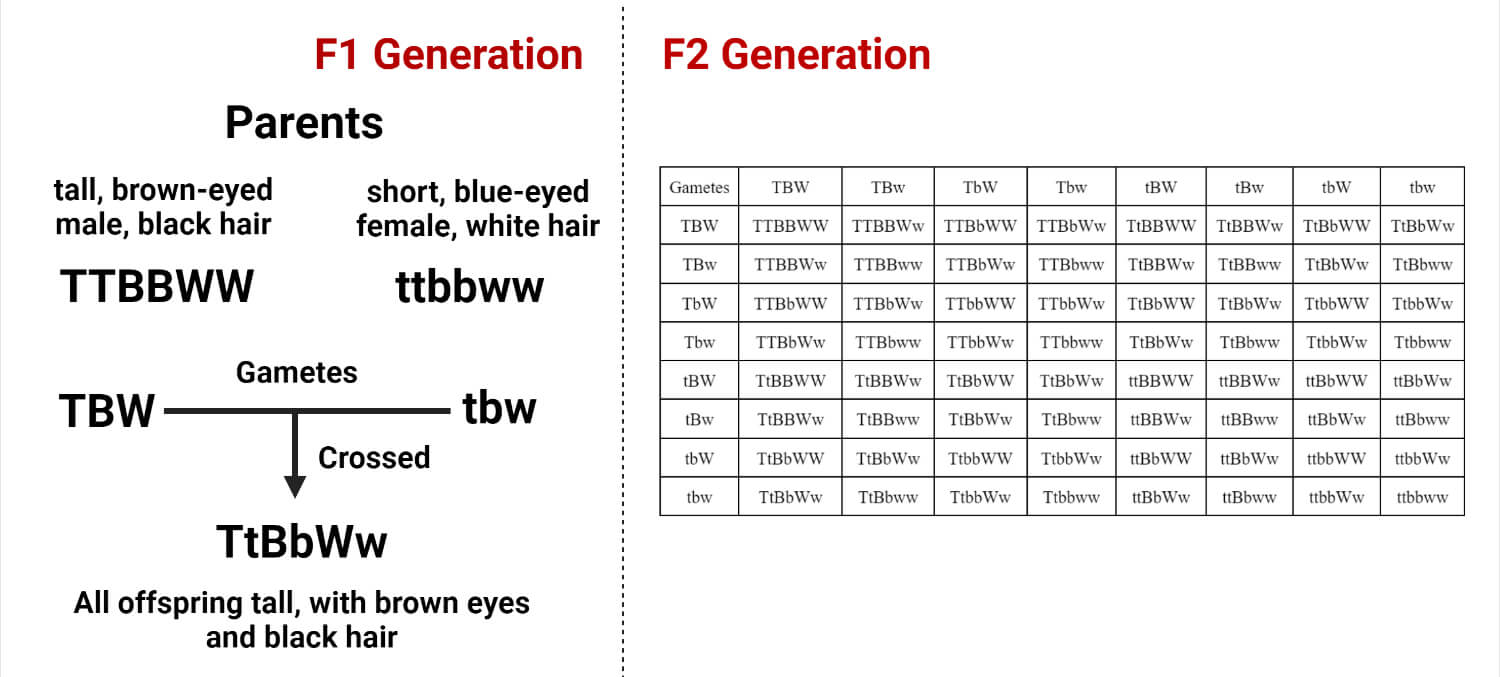The phenotypic ratio depicts the ratio or probability of the resulting patterns and frequencies of inherited observable traits in the offspring of organisms.
Phenotype is the morphological characteristic of an organism that can be observed externally. It includes the characters such as sex, hair and skin color, shape, height, etc. In simple language, the phenotype is the resulting appearance of an individual depending upon the inherited genotype.

An organism’s genes can be expressed (dominant) or unexpressed (recessive). The expressed genes result in the phenotypic characteristics of an organism.
Calculation of Phenotypic Ratio
The calculation of the ratio of phenotypes for monohybrid, dihybrid, and trihybrid crosses is different. The basic steps of calculation are:
- Choosing the characters to be crossed or the characters under study.
- By applying Mendel’s Laws of Inheritance, cross them by forming a cross diagram or Punnett-square chart.
- Then calculate the number of phenotypes (not be confused with the genotype). TT and Tt can denote tallness, and they both are the same phenotypes.
- The type of phenotypic outcomes must be listed distinctly. The ratio can be finally determined by adjusting the characters and their specific numbers (as counted in the Punnett chart) respectively.
Phenotypic Ratio in Monohybrid Cross
Monohybrid Cross is the type of cross in which a single trait of an individual is taken and studied for its outcomes after the cross.
Let’s take, for example, height: a tall father (TT) who is crossed with a short mother (tt) where tallness is dominant over shortness, then the cross-ratio can be calculated as follows:

The phenotypes in the second filial generation are tall (three: TT, Tt, Tt) and short (Only one: tt).
So the phenotypic ratio of short and tall will be 3:1, respectively. It simply indicates that if four offspring are born in the above case, then there is a higher probability of three of them being tall and one of them being short.
Phenotypic Ratio in Dihybrid Cross
Dihybrid Cross is the type of cross in which two characters or traits are considered, and the combined outcomes of both are calculated.
Let’s take, for example, height and color: a tall and white colored male (TTWW) who is crossed with a short and black female (ttww) (considering tallness and white skin are dominant over shortness and black skin), then the cross-ratio can be calculated as follows:

The phenotypes in the second filial generation are tall and white (nine: TTWW, TTWw, TtWW, TtWw); tall and black (three: TTww, Ttww); short and white (three: ttWw, ttWW); short and black (only one: ttww).
So the phenotypic will be 9:3:3:1, respectively, considering the above data and assumptions. It simply indicates that if 16 offspring are born in the above case, then there is a higher probability of nine of them being tall and white, considering the tall and white skin to be dominant and so on.
Phenotypic Ratio in Trihybrid Cross
Trihybrid Cross is the cross in which three characters are taken and studied for their combined outcomes in future generations. Let’s take, for example, height, eye, and hair color.
A tall, brown-eyed male with black hair (indicated by TTBBWW respectively) who is crossed with a short and blue-eyed female with white hair (ttbbww) (considering tallness (T), brown eye (B), and black hair (W) color are dominant over shortness (t), blue eye (b), and white hair color (w)), then the phenotypic-ratio can be calculated as follows:

The phenotypes in the second filial generation are:
- 27 with tall height, brown eyes, and black hair (TTBBWW, TTBBWw, TTBbWw, TtBbWw, TtBbWW, TtBBWW)
- 9 with tallness, brown eyes, and white hair (TTBBww, TTBbww, TtBBww, TtBbww)
- 9 with short height, brown eyes, and black hair (ttBBWW, ttBbWw, ttBBWw, ttBbWW)
- 9 with tall height, blue eyes, and black hair (TTbbWW, TtbbWw, TtbbWW, TTbbWw)
- 3 with tall height, blue eyes, and white hair (TTbbww, Ttbbww)
- 3 with short height, blue eyes, and black hair (ttbbWW, ttbbWw)
- 3 with short height, brown eyes, and white hair (ttBBww, ttBbww)
- 1 with short height, blue eyes, and white hair (ttbbww)
So the phenotypic ratio of short and tall will be 27:9:9:9:3:3:3:1 respectively. It simply indicates that the probability of offspring with all the dominant characters i.e. tallness, brown eyes, and black hair is highest and mathematically 27/64, and lowest for offspring with all recessive characters i.e. shortness, blue eyes, and white hair, in this case, that is mathematically 1/64.
Phenotypic Ratio Significances
- Calculating the phenotypic ratio helps us predict the likelihood of expressing particular parental traits in the progeny.
- It helps predict gene expressions in future generations of an organism.
- These calculations aid in producing genetically engineered crops and animals with the required external features.
Some Important Terms
Filial generation
The offspring or progenies obtained after the cross between parents are called filial generation or first filial generation (F1 generation). When those progenies self-fertilize and result in another generation of progenies, then they are the second filial generation (F2 generation).
Punnett square
It illustrates all the possible combinations of phenotypes in the offspring after crossing the specific traits of parents. It is represented in the form of a square-shaped table. R.C. Punnett invented it in the year 1906. In this table, all the possible gametes from the male are arranged in the top horizontal boxes, and all the gametes from the female are arranged in the left vertical boxes.
Note: All the above given phenotypic ratios are based on Mendel’s laws of inheritance where the mutation is not considered. All the characters in parents are based on homozygous alleles. The dominant allele is written in capital and at first whereas the recessive one is written in small.
Phenotypic Ratio vs. Genotypic Ratio
| Phenotypic Ratio | Genotypic Ratio |
| It is the ratio of external observable characters in the progenies of an organism. | It is the ratio of genes’ composition in an organism’s progenies. |
| It is influenced by the pattern of inheritance pattern of expressing genes, age, and environmental factors as well. | The pattern of inheritance of genes from parents influences the genotypic ratio. |
| If the individuals have a similar phenotype, it doesn’t necessarily mean they have similar genotypes. For eg., if two boys in the same family and generation are tall, then also they might have different allele compositions such as TT and Tt both result in tallness. | If the individuals possess similar genotypes, they mostly have similar phenotypes. |
| In the case of a monohybrid cross for a particular trait, the phenotype ratio is 3:1 in the second filial generation. | While in the same case of a monohybrid cross, the genotype ratio is 1:2:1 in the second filial generation. |
| It can be determined easily by the external appearance of an individual. | It is hard to determine as genetic arrangements also need to be studied. |
References
- Knapp S. (2020) Phenotypic Ratio. Accessed from: https://biologydictionary.net/phenotypic-ratio/ Accessed on: 11/28/2022
- Keshari A.K. and Ghimire K.R. (2010) Mendel’s Laws of Inheritance. Vidyarthi Pustak Bhandar. 4th ed. pg. 618-640.
- Ahluwalia, K.B. (2009) Genetics. 2nd ed. New Delhi. New Age International.Klug W.S. (2015). Concepts of Genetics. 11th ed. Boston
